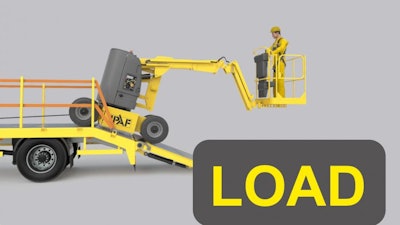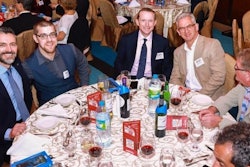
An accident analysis has highlighted a requirement to update the comprehensive training course on how to load and unload MEWPs and other equipment safely from trucks or trailers. This analysis was a worldwide project that reported potential and actual accidents.
The new comprehensive Global MEWP Safety Report, gathered by IPAF, shows most accidents, resulting in lost-time injuries and fatalities during delivery of MEWPs, occur during loading or unloading. As a result, IPAF decided to improve its existing Load and Unload course with new training materials. These changes are being unveiled to instructors in a Professional Development Seminar.
Earlier this year, IPAF updated and relaunched its Incident Reporting Portal, aimed at gathering more intricate data about not only accidents but also near-misses.
“Statistically the most-likely people to be involved in a MEWP-related incident are those loading and unloading — and these operatives are key to our industry," Peter Douglas, IPAF CEO and managing director, commented. "Analyzing data has allowed the updated training course to directly address those issues that affect people loading or unloading, and provide knowledge and recommended protocols to help prevent accidents before they happen.
“This is exactly the reason why we place so much emphasis on our accident reporting project — only through good data and exhaustive analysis of accidents and near-misses can we identify high-risk situations, uncover underlying causes of why operators get into difficulty and address these through our training program, industry technical guidance, Andy Access safety campaigns and Toolbox Talks series.”
According to the research provided, delivery drivers were the most susceptible to harm in MEWP-related incidents. To combat this statistic, IPAF's new training course aims to provide a more comprehensible procedure for equipping and protecting operatives during the loading and unloading process.
Paul Roddis, IPAF training manager, said, "We set up a working group formed of members of the IPAF Training Committee, led by Martin Wraith, an IPAF auditor and qualified training instructor, as he also has significant experience within the haulage industry.
“The revamped training is still an instructor-led theory course, though it has a completely new look and feel. We were able to incorporate information directly from the incident-reporting portal, to fine-tune the training so that it addresses the most common problems and risk scenarios anyone loading or unloading machines might face."
Visual Equipment Enhancement includes:
- A 4x4 with trailer
- A 3.5 ton flat-bed van
- A 7.5 ton beaver-tail
- A 26 ton rigid
- A 4 ton articulated HGV trailer
All information covered in the course content follows the EN 12195 Load-Restraining On-Road Vehicles Regulations and references both the IPAF Best Practice Guidance: Load and Unload, and Loading and Unloading MEWPS on the Public Highway.
“This is an excellent new course to complement those that the IPAF Training Center already offers. It is highly recommended learning for anyone operating, hiring, maintaining, delivering or managing MEWPs," Roddis added. "There is a great deal in the training course that is applicable to a range of plant machines, including dumpers, diggers, telehandlers, rollers or forklifts."



















